2007 TOYOTA SIENNA ignition
[x] Cancel search: ignitionPage 442 of 3000
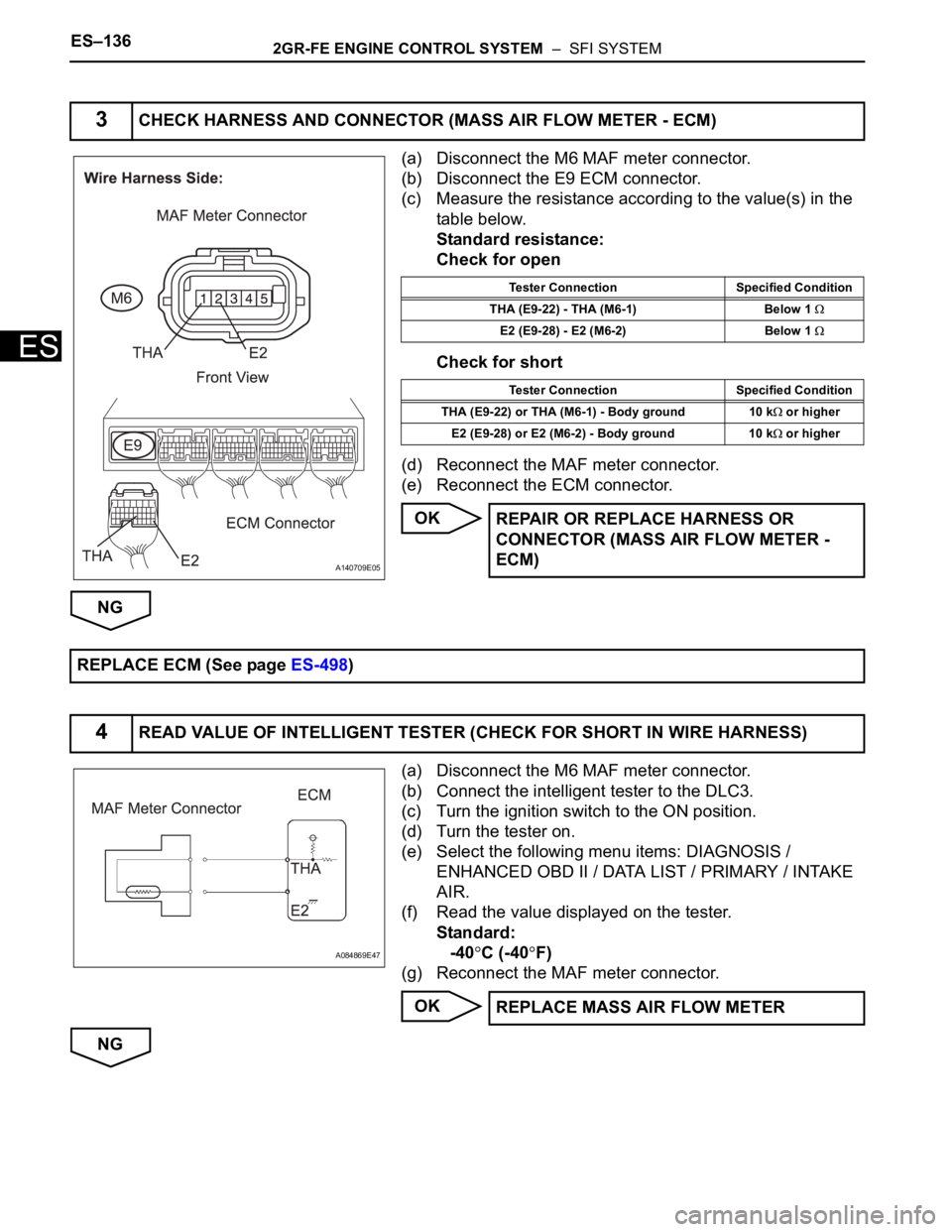
ES–1362GR-FE ENGINE CONTROL SYSTEM – SFI SYSTEM
ES
(a) Disconnect the M6 MAF meter connector.
(b) Disconnect the E9 ECM connector.
(c) Measure the resistance according to the value(s) in the
table below.
Standard resistance:
Check for open
Check for short
(d) Reconnect the MAF meter connector.
(e) Reconnect the ECM connector.
OK
NG
(a) Disconnect the M6 MAF meter connector.
(b) Connect the intelligent tester to the DLC3.
(c) Turn the ignition switch to the ON position.
(d) Turn the tester on.
(e) Select the following menu items: DIAGNOSIS /
ENHANCED OBD II / DATA LIST / PRIMARY / INTAKE
AIR.
(f) Read the value displayed on the tester.
Standard:
-40
C (-40F)
(g) Reconnect the MAF meter connector.
OK
NG
3CHECK HARNESS AND CONNECTOR (MASS AIR FLOW METER - ECM)
A140709E05
Tester Connection Specified Condition
THA (E9-22) - THA (M6-1) Below 1
E2 (E9-28) - E2 (M6-2) Below 1
Tester Connection Specified Condition
THA (E9-22) or THA (M6-1) - Body ground 10 k
or higher
E2 (E9-28) or E2 (M6-2) - Body ground 10 k
or higher
REPAIR OR REPLACE HARNESS OR
CONNECTOR (MASS AIR FLOW METER -
ECM)
REPLACE ECM (See page ES-498)
4READ VALUE OF INTELLIGENT TESTER (CHECK FOR SHORT IN WIRE HARNESS)
A084869E47
REPLACE MASS AIR FLOW METER
Page 444 of 3000
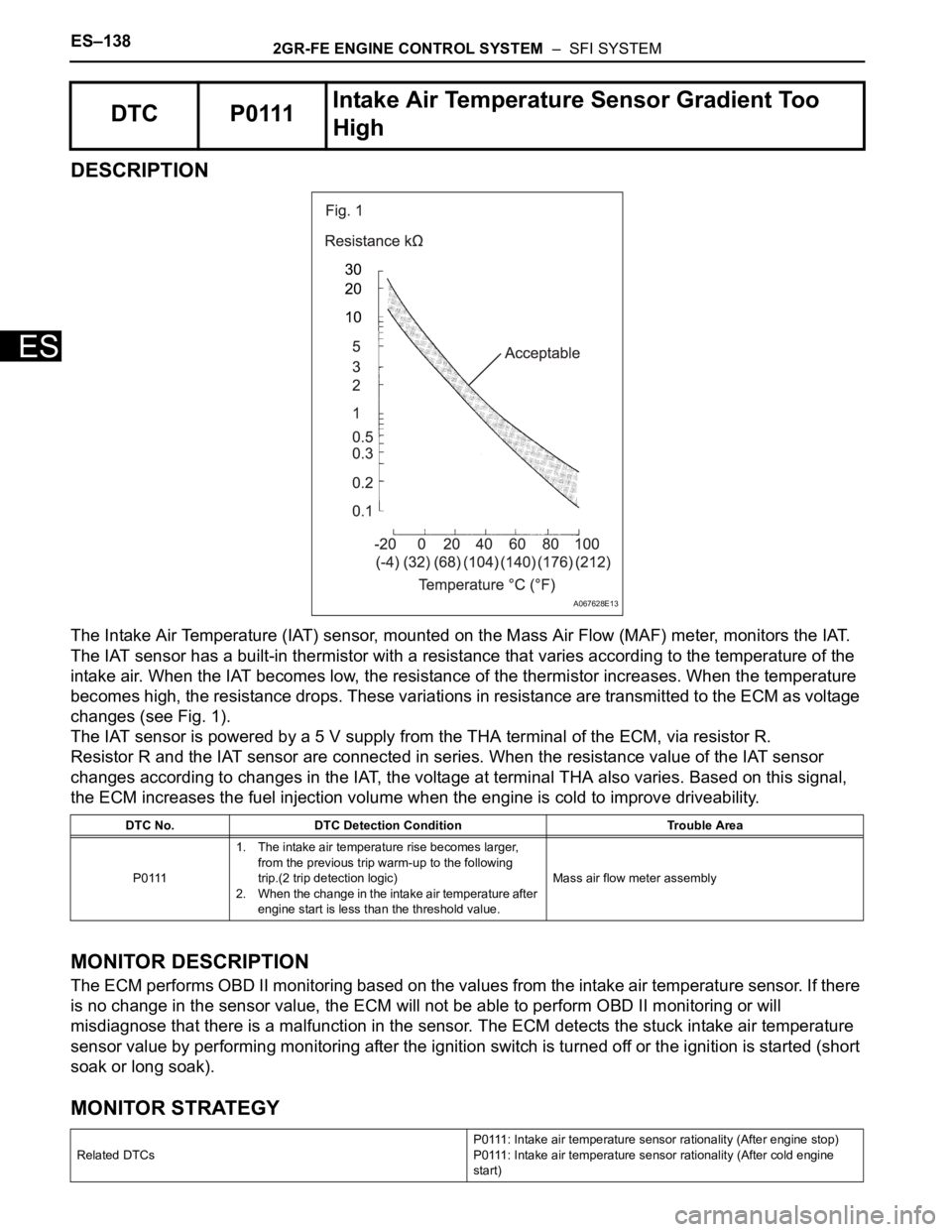
ES–1382GR-FE ENGINE CONTROL SYSTEM – SFI SYSTEM
ES
DESCRIPTION
The Intake Air Temperature (IAT) sensor, mounted on the Mass Air Flow (MAF) meter, monitors the IAT.
The IAT sensor has a built-in thermistor with a resistance that varies according to the temperature of the
intake air. When the IAT becomes low, the resistance of the thermistor increases. When the temperature
becomes high, the resistance drops. These variations in resistance are transmitted to the ECM as voltage
changes (see Fig. 1).
The IAT sensor is powered by a 5 V supply from the THA terminal of the ECM, via resistor R.
Resistor R and the IAT sensor are connected in series. When the resistance value of the IAT sensor
changes according to changes in the IAT, the voltage at terminal THA also varies. Based on this signal,
the ECM increases the fuel injection volume when the engine is cold to improve driveability.
MONITOR DESCRIPTION
The ECM performs OBD II monitoring based on the values from the intake air temperature sensor. If there
is no change in the sensor value, the ECM will not be able to perform OBD II monitoring or will
misdiagnose that there is a malfunction in the sensor. The ECM detects the stuck intake air temperature
sensor value by performing monitoring after the ignition switch is turned off or the ignition is started (short
soak or long soak).
MONITOR STRATEGY
DTC P0111Intake Air Temperature Sensor Gradient Too
High
DTC No. DTC Detection Condition Trouble Area
P01111. The intake air temperature rise becomes larger,
from the previous trip warm-up to the following
trip.(2 trip detection logic)
2. When the change in the intake air temperature after
engine start is less than the threshold value.Mass air flow meter assembly
Related DTCsP0111: Intake air temperature sensor rationality (After engine stop)
P0111: Intake air temperature sensor rationality (After cold engine
start)
A067628E13
Page 445 of 3000

2GR-FE ENGINE CONTROL SYSTEM – SFI SYSTEMES–139
ES
TYPICAL ENABLING CONDITIONS
All:
After engine stop:
After cold engine start:
TYPICAL MALFUNCTION THRESHOLDS
After engine stop:
After cold engine start:
WIRING DIAGRAM
Refer to DTC P0110 (See page ES-126).
INSPECTION PROCEDURE
(a) Connect the intelligent tester to the DLC3.
(b) Turn the ignition switch to the ON position.
(c) Turn the tester on.
(d) Enter the following menus: DIAGNOSIS / ENHANCED
OBD II / DTC INFO / CURRENT CODES.
Required Sensors / Components (Main) Intake Air Temperature (IAT) sensor
Required Sensors / Components (Sub) -
Frequency of Operation Once per driving cycle
Duration 5 hours
MIL Operation 2 driving cycles
Sequence of Operation None
Monitor runs whenever following DTCs are not present None
Time after engine start 10 seconds or more
Battery voltage 10.5 V or more
ECT sensor OK
ECT change since engine stopped Less than 180
C (356F)
ECT before engine stop 70
C (158F) or more
Time that MAF is low before engine stop 70 minutes
Accumulated MAF amount before engine stop 3774 g or more
Key-off duration 30 minutes
Key-off duration 5 hours
Time after engine start 10 seconds or more
ECT sensor OK
ECT 70
C (158F) or more
Accumulated MAF amount 3774 g or more
One of the following conditions 1 or 2 is met: -
1. Duration while engine load is low 120 seconds or more
2. Duration while engine load is high 10 seconds or more
IAT change Less than 1
C (2F)
IAT change Less than 1
C (2F)
1CHECK ANY OTHER DTCS OUTPUT (IN ADDITION TO DTC P0111)
Page 449 of 3000
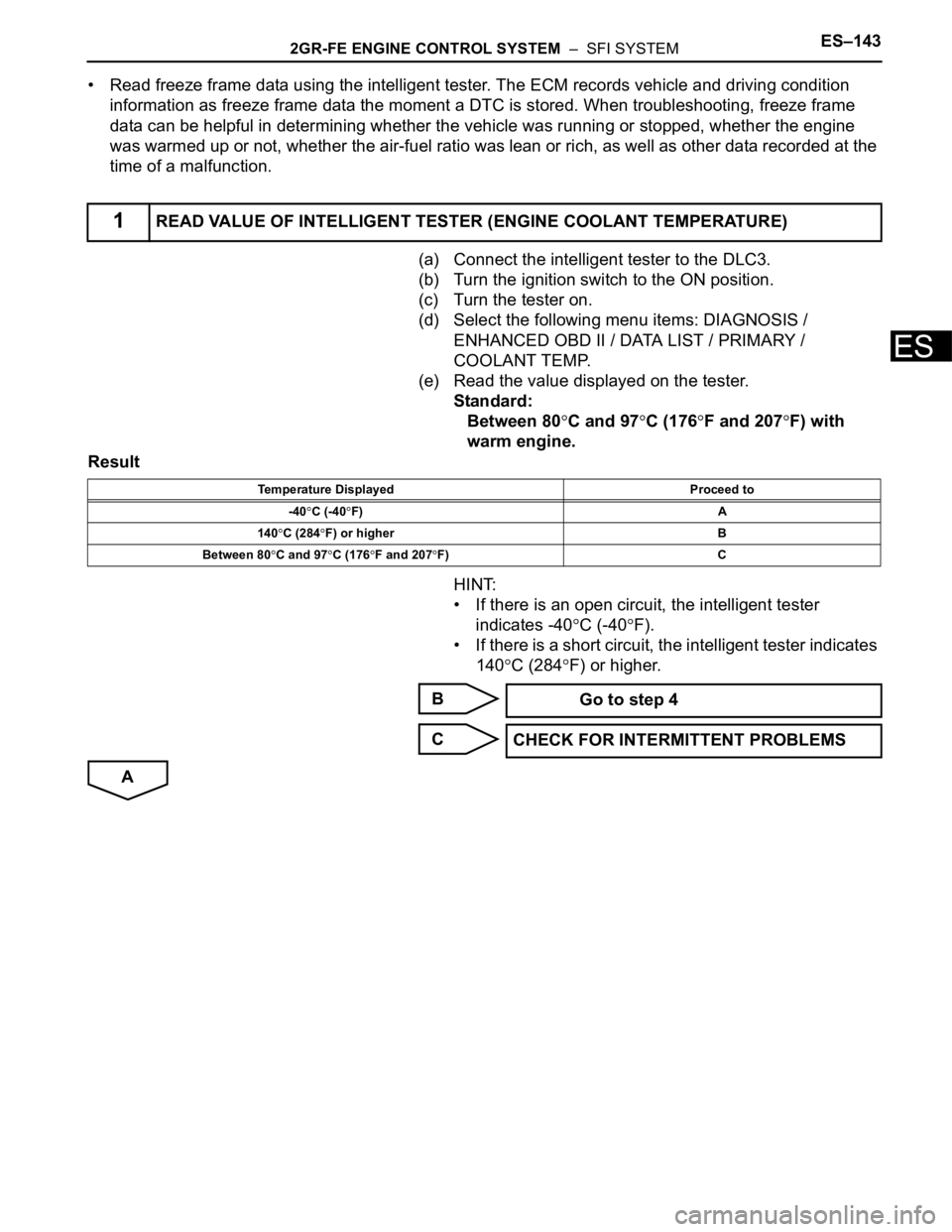
2GR-FE ENGINE CONTROL SYSTEM – SFI SYSTEMES–143
ES
• Read freeze frame data using the intelligent tester. The ECM records vehicle and driving condition
information as freeze frame data the moment a DTC is stored. When troubleshooting, freeze frame
data can be helpful in determining whether the vehicle was running or stopped, whether the engine
was warmed up or not, whether the air-fuel ratio was lean or rich, as well as other data recorded at the
time of a malfunction.
(a) Connect the intelligent tester to the DLC3.
(b) Turn the ignition switch to the ON position.
(c) Turn the tester on.
(d) Select the following menu items: DIAGNOSIS /
ENHANCED OBD II / DATA LIST / PRIMARY /
COOLANT TEMP.
(e) Read the value displayed on the tester.
Standard:
Between 80
C and 97C (176F and 207F) with
warm engine.
Result
HINT:
• If there is an open circuit, the intelligent tester
indicates -40
C (-40F).
• If there is a short circuit, the intelligent tester indicates
140
C (284F) or higher.
B
C
A
1READ VALUE OF INTELLIGENT TESTER (ENGINE COOLANT TEMPERATURE)
Temperature Displayed Proceed to
-40
C (-40F) A
140
C (284F) or higher B
Between 80
C and 97C (176F and 207F) C
Go to step 4
CHECK FOR INTERMITTENT PROBLEMS
Page 450 of 3000

ES–1442GR-FE ENGINE CONTROL SYSTEM – SFI SYSTEM
ES
(a) Disconnect the E12 Engine Coolant Temperature (ECT)
sensor connector.
(b) Connect terminals 1 and 2 of the ECT sensor connector
on the wire harness side.
(c) Connect the intelligent tester to the DLC3.
(d) Turn the ignition switch to the ON position.
(e) Turn the tester on.
(f) Select the following menu items: DIAGNOSIS /
ENHANCED OBD II / DATA LIST / PRIMARY /
COOLANT TEMP.
(g) Read the value displayed on the tester.
Standard:
140
C (284F) or higher
(h) Reconnect the ECT sensor connector.
OK
NG
(a) Disconnect the E12 ECT sensor connector.
(b) Disconnect the E9 ECM connector.
(c) Measure the resistance according to the value(s) in the
table below.
Standard resistance
(d) Reconnect the ECM connector.
(e) Reconnect the ECT connector.
OK
2READ VALUE OF INTELLIGENT TESTER (CHECK FOR OPEN IN WIRE HARNESS)
A114610E05
REPLACE ENGINE COOLANT
TEMPERATURE SENSOR (See page ES-516)
3CHECK HARNESS AND CONNECTOR (ENGINE COOLANT TEMPERATURE SENSOR -
ECM)
A162492E01
Tester Connection Specified Condition
THW (E9-21) - E12-2 Below 1
E2 (E9-28) - E12-1 Below 1
REPAIR OR REPLACE HARNESS OR
CONNECTOR (ENGINE COOLANT
TEMPERATURE SENSOR - ECM)
Page 451 of 3000
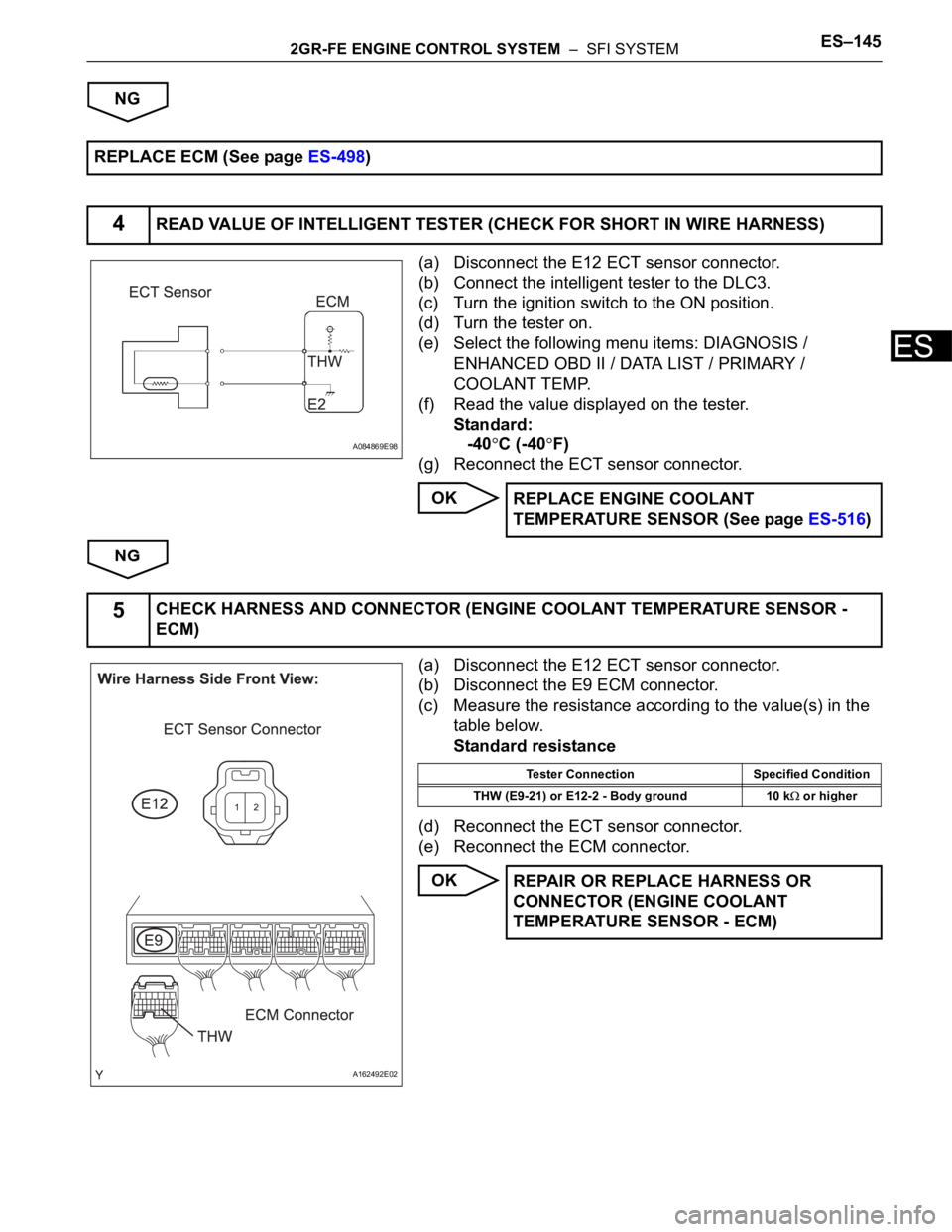
2GR-FE ENGINE CONTROL SYSTEM – SFI SYSTEMES–145
ES
NG
(a) Disconnect the E12 ECT sensor connector.
(b) Connect the intelligent tester to the DLC3.
(c) Turn the ignition switch to the ON position.
(d) Turn the tester on.
(e) Select the following menu items: DIAGNOSIS /
ENHANCED OBD II / DATA LIST / PRIMARY /
COOLANT TEMP.
(f) Read the value displayed on the tester.
Standard:
-40
C (-40F)
(g) Reconnect the ECT sensor connector.
OK
NG
(a) Disconnect the E12 ECT sensor connector.
(b) Disconnect the E9 ECM connector.
(c) Measure the resistance according to the value(s) in the
table below.
Standard resistance
(d) Reconnect the ECT sensor connector.
(e) Reconnect the ECM connector.
OK REPLACE ECM (See page ES-498)
4READ VALUE OF INTELLIGENT TESTER (CHECK FOR SHORT IN WIRE HARNESS)
A084869E98
REPLACE ENGINE COOLANT
TEMPERATURE SENSOR (See page ES-516)
5CHECK HARNESS AND CONNECTOR (ENGINE COOLANT TEMPERATURE SENSOR -
ECM)
A162492E02
Tester Connection Specified Condition
THW (E9-21) or E12-2 - Body ground 10 k
or higher
REPAIR OR REPLACE HARNESS OR
CONNECTOR (ENGINE COOLANT
TEMPERATURE SENSOR - ECM)
Page 454 of 3000

ES–1482GR-FE ENGINE CONTROL SYSTEM – SFI SYSTEM
ES
TYPICAL ENABLING CONDITIONS
All:
ECT sensor cold start monitor:
ECT sensor soak monitor:
TYPICAL MALFUNCTION THRESHOLDS
ECT sensor cold start monitor:
ECT sensor soak monitor:
COMPONENT OPERATING RANGE
INSPECTION PROCEDURE
HINT:
• If any of DTC P0115, P0117, P0118 or P0125 are set simultaneously with DTC P0116, the ECT sensor
may have an open or a short circuit. Troubleshoot those DTCs first.
• Read freeze frame data using the intelligent tester. The ECM records vehicle and driving condition
information as freeze frame data the moment a DTC is stored. When troubleshooting, freeze frame
data can be helpful in determining whether the vehicle was running or stopped, whether the engine
was warmed up or not, whether the air-fuel ratio was lean or rich, as well as other data recorded at the
time of a malfunction.
(a) Connect the intelligent tester to the DLC3.
(b) Turn the ignition switch to the ON position.
(c) Turn the tester on.
(d) Enter the following menus: DIAGNOSIS / ENHANCED II
/ DTC INFO / CURRENT CODES.
(e) Read the DTC.
Monitor will run whenever these DTCs are not present. P0100, P0102, P0103 (MAF Sensor)
Battery voltage 10.5 V or more
Time after engine start 1 second or more
ECT at engine start Less than 60
C (140F)
IAT sensor circuit OK
Soak time 5 hours or more
Accumulated MAF 1421.2 g or more
Engine Running
Fuel cut OFF
Difference between ECT at engine start and IAT Less than 40
C (72F)
Battery voltage 10.5 V or more
Engine Running
Soak time 5 hours or more
ECT at engine start 60
C (140F) or more
Accumulated MAF 3298.1 g or more
ECT sensor value change Less than 5
C (9F)
ECT sensor value change Less than 5
C (9F)
Engine coolant temperature Varies with actual engine coolant temperature
1CHECK ANY OTHER DTCS OUTPUT (IN ADDITION TO DTC P0166)
Page 456 of 3000
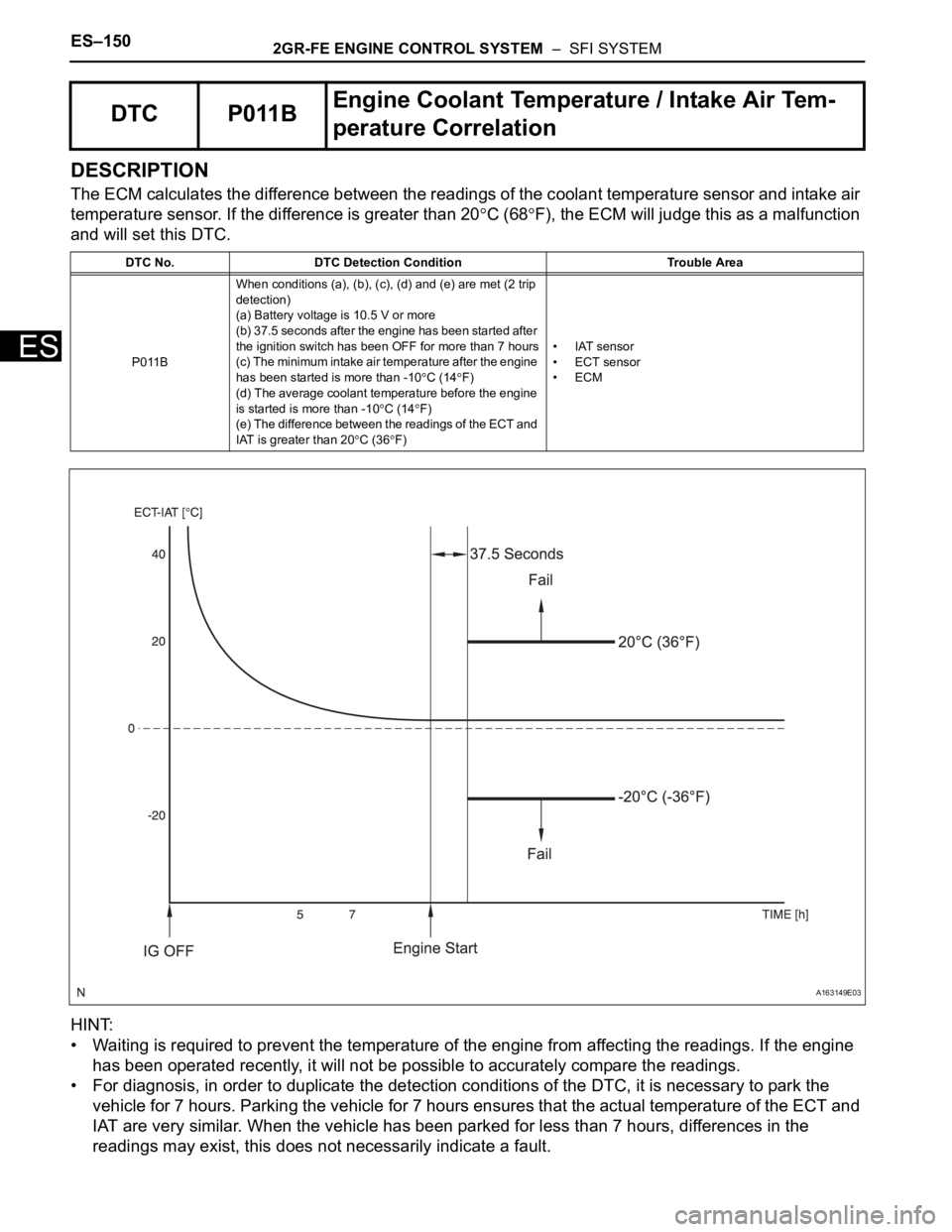
ES–1502GR-FE ENGINE CONTROL SYSTEM – SFI SYSTEM
ES
DESCRIPTION
The ECM calculates the difference between the readings of the coolant temperature sensor and intake air
temperature sensor. If the difference is greater than 20
C (68F), the ECM will judge this as a malfunction
and will set this DTC.
HINT:
• Waiting is required to prevent the temperature of the engine from affecting the readings. If the engine
has been operated recently, it will not be possible to accurately compare the readings.
• For diagnosis, in order to duplicate the detection conditions of the DTC, it is necessary to park the
vehicle for 7 hours. Parking the vehicle for 7 hours ensures that the actual temperature of the ECT and
IAT are very similar. When the vehicle has been parked for less than 7 hours, differences in the
readings may exist, this does not necessarily indicate a fault.
DTC P011BEngine Coolant Temperature / Intake Air Tem-
perature Correlation
DTC No. DTC Detection Condition Trouble Area
P011BWhen conditions (a), (b), (c), (d) and (e) are met (2 trip
detection)
(a) Battery voltage is 10.5 V or more
(b) 37.5 seconds after the engine has been started after
the ignition switch has been OFF for more than 7 hours
(c) The minimum intake air temperature after the engine
has been started is more than -10
C (14F)
(d) The average coolant temperature before the engine
is started is more than -10
C (14F)
(e) The difference between the readings of the ECT and
IAT is greater than 20
C (36F)•IAT sensor
• ECT sensor
•ECM
A163149E03